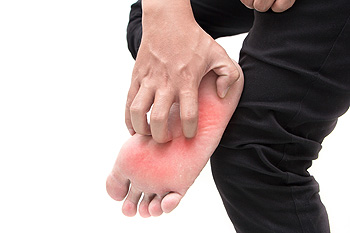Research has indicated the foot condition, athlete’s foot, is the most common infection of the skin. It is caused by a fungus that typically lives and thrives in moist and warm environments. These areas can include public swimming pools, as well as shower room and locker room floors. This condition is considered to be contagious, so it is beneficial to wear appropriate shoes while in these places. Common symptoms that are associated with athlete’s foot are: severe itchiness between the toes and on the bottom of the feet, cracked skin, and small blisters. Methods that can be implemented to help prevent this condition from developing are: wearing shoes that are made of breathable materials, keeping the feet clean, and using an antifungal powder. If you have athlete’s foot, and would like information about additional treatment options, please consult with a podiatrist.
Athlete’s foot is an inconvenient condition that can be easily reduced with the proper treatment. If you have any concerns about your feet and ankles, contact one of our podiatrists from New York Foot and Ankle. Our doctors will treat your foot and ankle needs.
Athlete’s Foot: The Sole Story
Athlete's foot, also known as tinea pedis, can be an extremely contagious foot infection. It is commonly contracted in public changing areas and bathrooms, dormitory style living quarters, around locker rooms and public swimming pools, or anywhere your feet often come into contact with other people.
Solutions to Combat Athlete’s Foot
- Hydrate your feet by using lotion
- Exfoliate
- Buff off nails
- Use of anti-fungal products
- Examine your feet and visit your doctor if any suspicious blisters or cuts develop
Athlete’s foot can cause many irritating symptoms such as dry and flaking skin, itching, and redness. Some more severe symptoms can include bleeding and cracked skin, intense itching and burning, and even pain when walking. In the worst cases, Athlete’s foot can cause blistering as well. Speak to your podiatrist for a better understanding of the different causes of Athlete’s foot, as well as help in determining which treatment options are best for you.
If you have any questions please feel free to contact one of our offices located in Franklin Square, Bethpage, Bronx, and Brooklyn, NY. We offer the newest diagnostic and treatment technologies for all your foot and ankle needs.
Read more about Athlete's Foot
